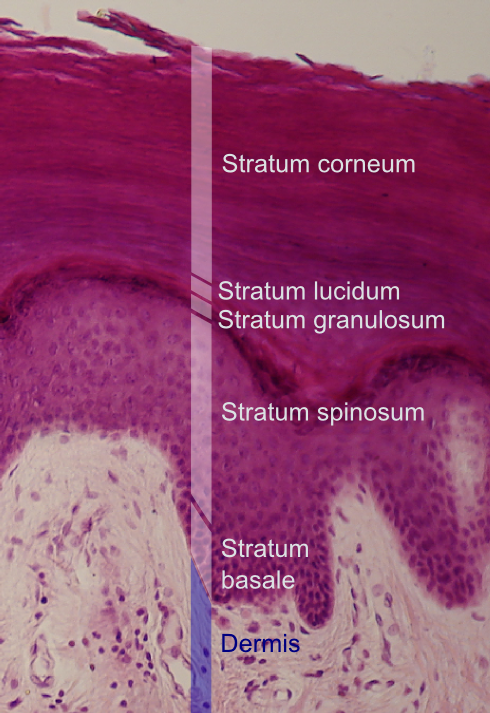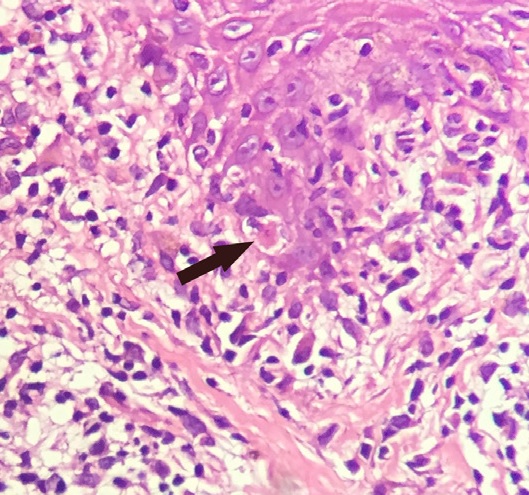|
Exfoliatin
Exfoliatin is a ''Staphylococcus aureus'' exotoxin that causes a blistering of the skin known as staphylococcal scalded skin syndrome, usually in infants. Exfoliatins are glutamate-specific serine proteases highly specific to desmoglein I, a cadherin (adhesion protein) in the desmosomes of the stratum granulosum that facilitates cell adhesion , intercellular adhesion between keratinocytes. The resulting vesicle is an intraepidermal cleft located above the basal cells (suprabasal), between the stratum corneum and stratum spinosum. Desmoglein-1 is similarly involved in Pemphigus foliaceus, Pemphigus foliaceus, an auto-immune skin condition. A very similar non-infectious condition is seen in the autoimmune skin disorder pemphigus vulgaris in which there is an Immunoglobulin G, IgG antibody against the cadherin desmoglein 3. See also * Exfoliation (other) * Staphylococcus aureus#Exfoliative toxins, Staphylococcus aureus — Exfoliative toxins References {{Toxins Stap ... [...More Info...] [...Related Items...] OR: [Wikipedia] [Google] [Baidu] |
Staphylococcal Scalded Skin Syndrome
Staphylococcal scalded skin syndrome (SSSS) is a dermatology, dermatological condition caused by ''Staphylococcus aureus''. Signs and symptoms The disease presents with the widespread formation of fluid-filled blisters that are thin walled and easily ruptured, and the patient can be positive for Nikolsky's sign. SSSS bears a resemblance to thermal burns or scalding, hence the condition's name. Ritter's disease of the newborn is the most severe form of SSSS, with similar signs and symptoms. SSSS often includes a widespread painful erythroderma, often involving the face, diaper, and other intertriginous areas. Extensive areas of desquamation might be present. Perioral crusting and fissuring are seen early in the course. Unlike toxic epidermal necrolysis, SSSS spares the mucous membranes. Children with SSSS may exhibit fussiness or irritability, tiredness, fever, redness of the skin, easily broken fluid-filled blisters that leave an area of moist, tender, painful skin, and large s ... [...More Info...] [...Related Items...] OR: [Wikipedia] [Google] [Baidu] |
Desmoglein I
Desmoglein-1 is a protein that in humans is encoded by the ''DSG1'' gene. Desmoglein-1 is expressed everywhere in the skin epidermis, but mainly it is expressed in the superficial upper layers of the skin epidermis. Function Desmosomes are cell-cell junctions between epithelial, myocardial and certain other cell types. Desmoglein-1 is a calcium-binding transmembrane glycoprotein component of desmosomes in vertebrate epithelial cells. Currently, four desmoglein subfamily members have been identified and all are members of the cadherin cell adhesion molecule superfamily. These desmoglein gene family members are located in a cluster on chromosome 18. The protein encoded by this gene has been identified as the autoantigen of the autoimmune skin blistering disease pemphigus foliaceus. It has been found that desmoglein-1 is the target antigen in majority of the cases linked to IgG/IgA pemphigus, which is an autoimmune IgG/IgA antibody mediated response. Desmoglein-1 is also a target ... [...More Info...] [...Related Items...] OR: [Wikipedia] [Google] [Baidu] |
Staphylococcus Aureus
''Staphylococcus aureus'' is a Gram-positive spherically shaped bacterium, a member of the Bacillota, and is a usual member of the microbiota of the body, frequently found in the upper respiratory tract and on the skin. It is often positive for catalase and nitrate reduction and is a facultative anaerobe, meaning that it can grow without oxygen. Although ''S. aureus'' usually acts as a commensal of the human microbiota, it can also become an opportunistic pathogen, being a common cause of skin infections including abscesses, respiratory infections such as sinusitis, and food poisoning. Pathogenic strains often promote infections by producing virulence factors such as potent protein toxins, and the expression of a cell-surface protein that binds and inactivates antibodies. ''S. aureus'' is one of the leading pathogens for deaths associated with antimicrobial resistance and the emergence of antibiotic-resistant strains, such as methicillin-resistant ''S. aur ... [...More Info...] [...Related Items...] OR: [Wikipedia] [Google] [Baidu] |
Stratum Spinosum
The stratum spinosum (or spinous layer/prickle cell layer) is a layer of the epidermis found between the stratum granulosum and stratum basale. This layer is composed of polyhedral keratinocytes. These are joined with desmosomes. Their spiny (Latin, spinosum) appearance is due to shrinking of the microfilament Microfilaments, also called actin filaments, are protein filaments in the cytoplasm of eukaryotic cells that form part of the cytoskeleton. They are primarily composed of polymers of actin, but are modified by and interact with numerous other ...s between desmosomes that occurs when stained with H&E. Keratinization begins in the stratum spinosum, although the actual keratinocytes begin in the stratum basale. They have large pale-staining nuclei as they are active in synthesizing fibrillar proteins, known as cytokeratin, which build up within the cells aggregating together forming tonofibrils. The tonofibrils go on to form the desmosomes, which allow for strong ... [...More Info...] [...Related Items...] OR: [Wikipedia] [Google] [Baidu] |
Exfoliation (other) , a skin disease process involving redness and scaling of most or all of the sufferer's skin, with various causes
{{disambig ...
Exfoliation can refer to: * Exfoliation (botany), the loss of leaves (or, in some cases, pieces of bark) from a plant * Exfoliation (cosmetology), a cosmetic technique that aims to remove dead skin from the body and face * Exfoliation (geology), a process resulting in parallel fractures in the surface of rock * Exfoliation corrosion (metallurgy), a severe type of intergranular corrosion * Exfoliation (chemistry), the complete separation of the layers of a material * Exfoliation syndrome, an eye disease See also * Exfoliative dermatitis, sometimes known as erythroderma Erythroderma is an inflammatory skin disease with erythema, redness and scaling that affects nearly the entire cutaneous surface.Freedberg, et al. (2003). ''Fitzpatrick's Dermatology in General Medicine''. (6th ed.). McGraw-Hill. p. 436. . This te ... [...More Info...] [...Related Items...] OR: [Wikipedia] [Google] [Baidu] |
Desmoglein 3
Desmoglein-3 is a protein that in humans is encoded by the ''DSG3'' gene. In the skin epidermis Desmoglein-3 is expressed in the basal lower layers of the epidermis, and dominates in terms of expression on mucosal surfaces compared to Desmoglein-1. Function Desmosomes are cell-cell junctions between epithelial, myocardial, and certain other cell types. Desmoglein 3 is a calcium-binding transmembrane glycoprotein component of desmosomes in vertebrate epithelial cells. Currently, four desmoglein subfamily members have been identified and all are members of the cadherin cell adhesion molecule superfamily. These desmoglein gene family members are located in a cluster on chromosome 18. This protein, along with Desmoglein-1, has been identified as the autoantigen of the autoimmune skin blistering disease pemphigus vulgaris Pemphigus vulgaris is a rare chronic blistering skin disease and the most common form of pemphigus. Pemphigus was derived from the Greek word ''pemphix'', meani ... [...More Info...] [...Related Items...] OR: [Wikipedia] [Google] [Baidu] |
Immunoglobulin G
Immunoglobulin G (IgG) is a type of antibody. Representing approximately 75% of serum antibodies in humans, IgG is the most common type of antibody found in blood circulation. IgG molecules are created and released by plasma B cells. Each IgG antibody has two paratopes. Function Antibodies are major components of humoral immunity. IgG is the main type of antibody found in blood and extracellular fluid, allowing it to control infection of body tissues. By binding many kinds of pathogens such as viruses, bacteria, and fungi, IgG protects the body from infection. It does this through several mechanisms: * IgG-mediated binding of pathogens causes their immobilization and binding together via agglutination; IgG coating of pathogen surfaces (known as opsonization) allows their recognition and ingestion by phagocytic immune cells leading to the elimination of the pathogen itself; * IgG activates the classical pathway of the complement system, a cascade of immune protein product ... [...More Info...] [...Related Items...] OR: [Wikipedia] [Google] [Baidu] |
Pemphigus Vulgaris
Pemphigus vulgaris is a rare chronic blistering skin disease and the most common form of pemphigus. Pemphigus was derived from the Greek word ''pemphix'', meaning blister. It is classified as a type II hypersensitivity reaction in which antibody, antibodies are formed against desmosomes, components of the skin that function to keep certain layers of skin bound to each other. As desmosomes are attacked, the layers of skin separate and the clinical picture resembles a blister. These blisters are due to acantholysis, or breaking apart of intercellular connections through an autoantibody-mediated response. Over time the condition inevitably progresses without treatment: lesions increase in size and distribution throughout the body, behaving physiologically like a severe burn. Before the advent of modern treatments, mortality for the disease was close to 90%. Today, the mortality rate with treatment is in the range of 5% to 15%, after the introduction of corticosteroids as primary tr ... [...More Info...] [...Related Items...] OR: [Wikipedia] [Google] [Baidu] |
Pemphigus Foliaceus
Pemphigus foliaceus is an autoimmune blistering disease of the skin. Pemphigus foliaceus causes a characteristic inflammatory attack at the subcorneal layer of epidermis, which results in skin lesions that are scaly or crusted erosions with an erythematous (red) base.Freedberg, et al. (2003). ''Fitzpatrick's Dermatology in General Medicine''. (6th ed.). Page 558–562. McGraw-Hill. . Mucosal involvement is absent even with widespread disease. If there is an autoimmune IgG buildup in the epidermis, then nearly all of the antibodies are aimed against desmoglein 1. The effect of the antibodies and the immunological pathway is most likely one of three mechanisms: * Steric hindrance of the desmoglein 1: The antibody caps off the site for intracellular binding to another keratinocyte. * Activation of an endocytic pathway: The antibody activates a pathway which causes an internalization of desmogleïn 1, which in turn causes a loss of adhesion. * Disruption of function: In this case, ... [...More Info...] [...Related Items...] OR: [Wikipedia] [Google] [Baidu] |
Keratinocytes
Keratinocytes are the primary type of cell found in the epidermis, the outermost layer of the skin. In humans, they constitute 90% of epidermal skin cells. Basal cells in the basal layer (''stratum basale'') of the skin are sometimes referred to as basal keratinocytes. Keratinocytes form a barrier against environmental damage by heat, UV radiation, water loss, pathogenic bacteria, fungi, parasites, and viruses. A number of structural proteins, enzymes, lipids, and antimicrobial peptides contribute to maintain the important barrier function of the skin. Keratinocytes differentiate from epidermal stem cells in the lower part of the epidermis and migrate towards the surface, finally becoming corneocytes and eventually being shed, which happens every 40 to 56 days in humans. Function The primary function of keratinocytes is the formation of a barrier against environmental damage by heat, UV radiation, dehydration, pathogenic bacteria, fungi, parasites, and viruses. Pa ... [...More Info...] [...Related Items...] OR: [Wikipedia] [Google] [Baidu] |
Stratum Corneum
The stratum corneum (Latin language, Latin for 'horny layer') is the outermost layer of the epidermis (skin), epidermis. Consisting of dead tissue, it protects underlying tissue from infection, dehydration, chemicals and mechanical stress. It is composed of 15–20 layers of flattened cells with no nuclei and cell organelles. Among its properties are mechanical shear, impact resistance, water flux and hydration regulation, microbial proliferation and invasion regulation, initiation of inflammation through cytokine activation and dendritic cell activity, and selective permeability to exclude toxins, irritants, and allergens. The cytoplasm of its cells shows filamentous keratin. These corneocytes are embedded in a lipid matrix composed of ceramides, cholesterol, and fatty acids. Desquamation is the process of cell shedding from the surface of the stratum corneum, balancing proliferating keratinocytes that form in the stratum basale. These cells migrate through the epidermis tow ... [...More Info...] [...Related Items...] OR: [Wikipedia] [Google] [Baidu] |





